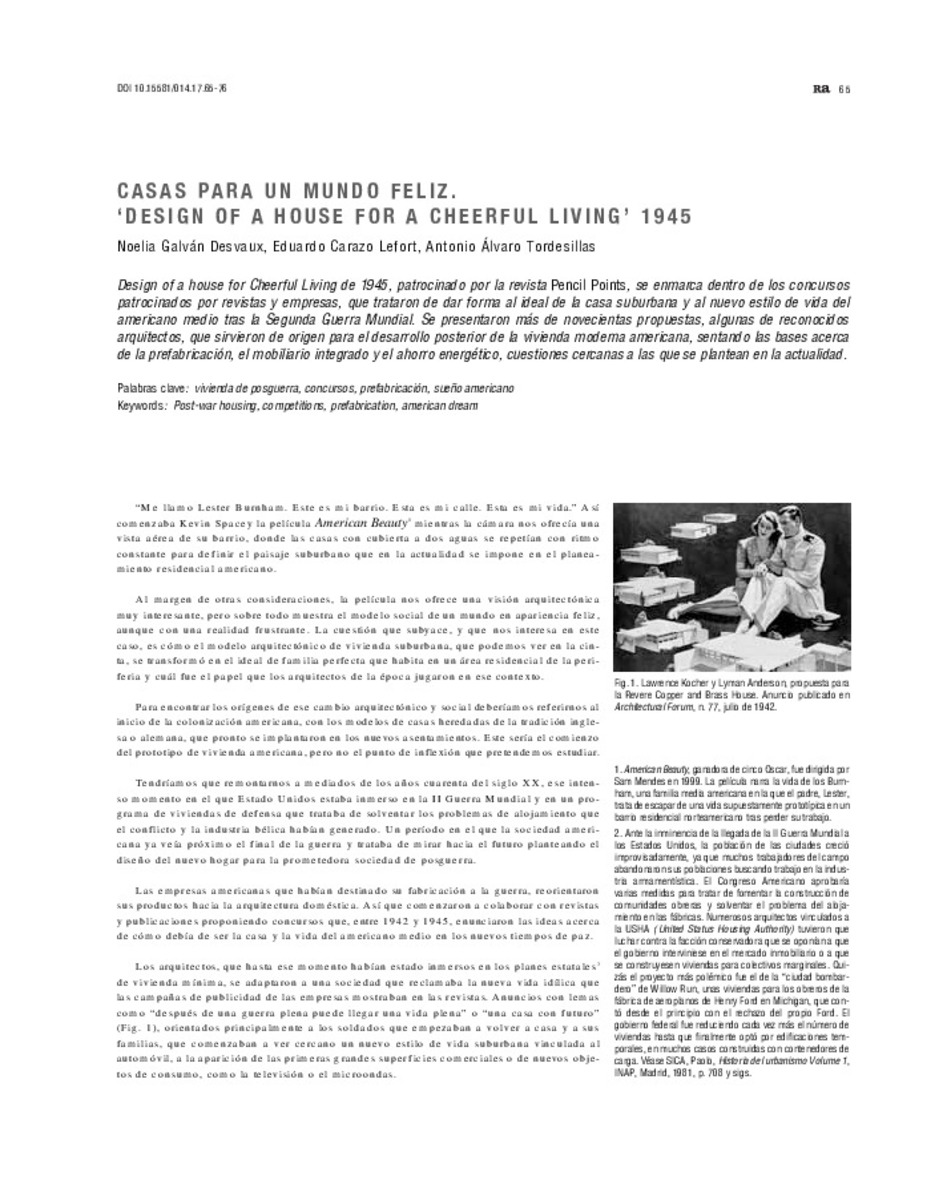Full metadata record
| DC Field | Value | Language |
|---|---|---|
| dc.creator | Galván-Desvaux, N. (Noelia) | - |
| dc.creator | Carazo-Lefort, E. (Eduardo) | - |
| dc.creator | Álvaro-Tordesillas, A. (Antonio) | - |
| dc.date.accessioned | 2016-11-09T10:50:50Z | - |
| dc.date.available | 2016-11-09T10:50:50Z | - |
| dc.date.issued | 2015 | - |
| dc.identifier.citation | Tordesillas, A. (2015). Casas para un mundo feliz. 'Design of a house for a cheerful living' 1945. Revista de Arquitectura, 17, pp. 65-76 | es_ES |
| dc.identifier.issn | 1138-5596 | - |
| dc.identifier.uri | https://hdl.handle.net/10171/42162 | - |
| dc.description.abstract | Design of a house for Cheerful Living de 1945, patrocinado por la revista Pencil Points, se enmarca dentro de los concursos patrocinados por revistas y empresas, que trataron de dar forma al ideal de la casa suburbana y al nuevo estilo de vida del americano medio tras la Segunda Guerra Mundial. Se presentaron más de novecientas propuestas, algunas de reconocidos arquitectos, que sirvieron de origen para el desarrollo posterior de la vivienda moderna americana, sentando las bases acerca de la prefabricación, el mobiliario integrado y el ahorro energético, cuestiones cercanas a las que se plantean en la actualidad. | es_ES |
| dc.description.abstract | The development of the American modern house had much to do with the numerous competitions held in the United States during the 1940s. The residential projects funded by the state were no longer built from 1943, and then the architecture tried to look ahead bringing up the design of the new post-war home. Many publications and manufacturers proposed imaginative architectural competitions, aiming to shape the ideal suburban house and the new lifestyle of the average American after the conflict. The competition “ Design of a House for Cheerful Living” from 1945, sponsored by Pencil Points magazine and the two glass companies Pittsburgh Plate Glass Co. and Pittsburgh Corning Corp., is part of this series of post-war contests. However, the reason why this competition is especially interesting as a subject of study is its synchronism with the end of the Second World War and the beginning of the euphoria and change in the American society. More than 900 proposals, many of them from renowned architects, were submitted to the competition. They provided the basis for the further development of the house, laying the foundations of prefabrication, integrated furniture and energy efficiency, issues surprisingly close to our contemporary concerns. In this way, besides showing the housing projects, the formal evolution suffered in the domestic post-war architecture will also be examined through the projects submitted by Louis Kahn, Marcel Breuer, Ralph Rapson, Philiph Johnson and Norman Fletcher. As it will be discussed, all this contributed to a deeper social change, where architects played a key role since their perspective on domestic architecture in the different competitions turned into the image of the perfect family inhabiting in a suburban residential area. | es_ES |
| dc.language.iso | spa | es_ES |
| dc.publisher | Servicio de Publicaciones de la Universidad de Navarra | es_ES |
| dc.rights | info:eu-repo/semantics/openAccess | es_ES |
| dc.subject | Sueño Americano | es_ES |
| dc.subject | concursos | es_ES |
| dc.subject | Vivienda de posguerra | es_ES |
| dc.subject | Prefabricación | es_ES |
| dc.title | Casas para un mundo feliz. 'Design of a house for a cheerful living' 1945 | es_ES |
| dc.title.alternative | 'Design of a House for a Cheerful Living' 1945 | es_ES |
| dc.type | info:eu-repo/semantics/article | es_ES |
| dc.identifier.doi | 10.15581/014.17.65-76 | es_ES |
Files in This Item:
Statistics and impact
Items in Dadun are protected by copyright, with all rights reserved, unless otherwise indicated.






